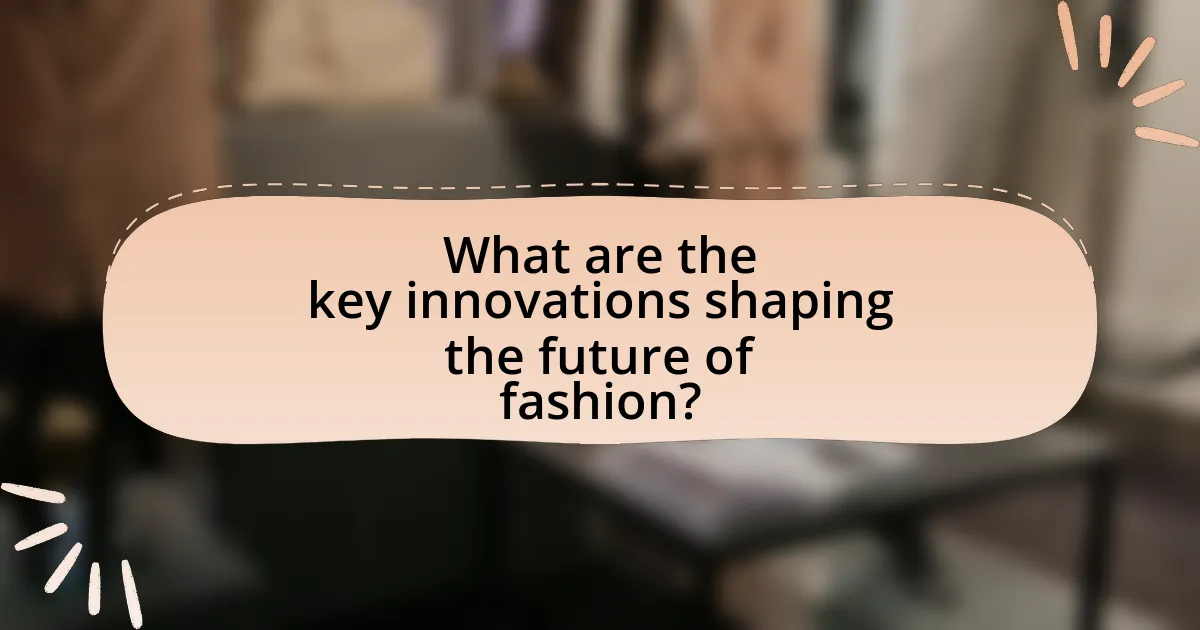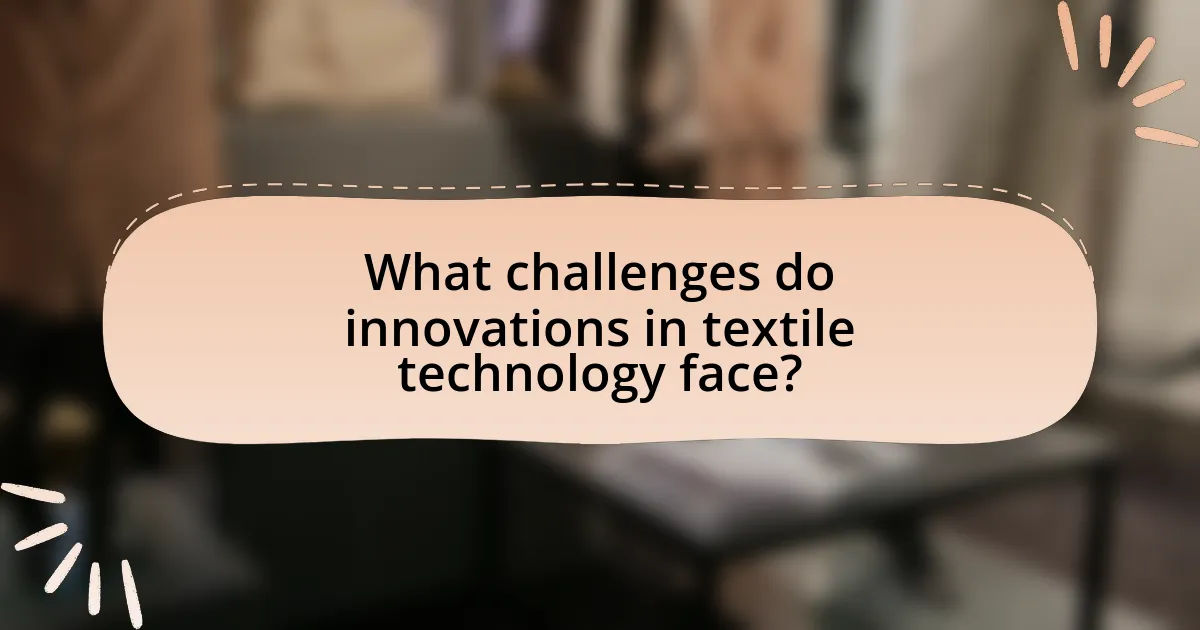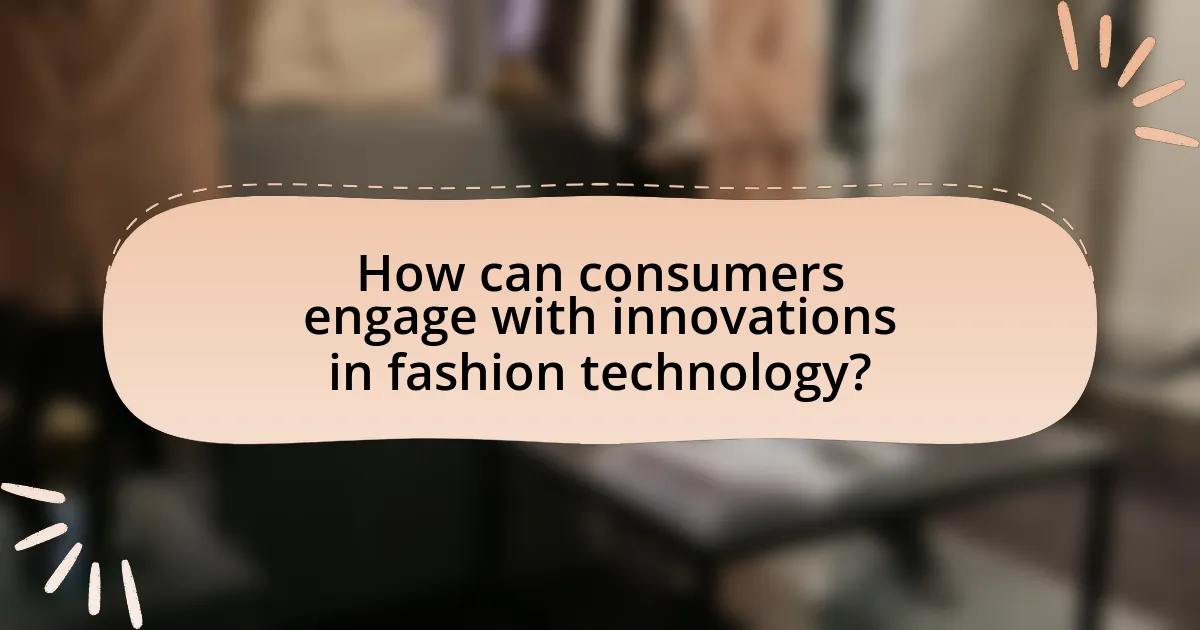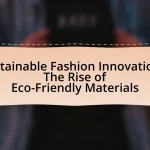The article focuses on the future of fashion, emphasizing innovations in textile technology and production methods. Key advancements include the use of sustainable materials, such as mycelium leather and recycled fibers, alongside 3D printing and digital fashion technologies that enhance customization and reduce waste. The piece also explores how advancements in textile technology influence design, the role of automation in production, and the economic implications of adopting new technologies. Additionally, it addresses environmental concerns, waste management strategies, and the importance of consumer engagement in supporting sustainable practices within the fashion industry.

What are the key innovations shaping the future of fashion?
Key innovations shaping the future of fashion include sustainable materials, 3D printing, and digital fashion technologies. Sustainable materials, such as bio-fabricated textiles and recycled fibers, reduce environmental impact and promote circular fashion. For instance, companies like Stella McCartney are utilizing mycelium leather, which is biodegradable and requires fewer resources than traditional leather.
3D printing allows for on-demand production, minimizing waste and enabling customization. Brands like Adidas have implemented 3D printing to create shoes tailored to individual specifications, significantly reducing excess inventory.
Digital fashion technologies, including augmented reality (AR) and virtual reality (VR), are transforming the shopping experience by allowing consumers to try on clothes virtually. This innovation not only enhances customer engagement but also reduces the need for physical samples, further decreasing waste.
These innovations collectively drive the fashion industry towards a more sustainable and efficient future.
How are advancements in textile technology influencing fashion design?
Advancements in textile technology are significantly influencing fashion design by enabling the creation of innovative materials that enhance functionality, sustainability, and aesthetic appeal. For instance, the development of smart textiles, which incorporate sensors and electronics, allows designers to create garments that can monitor health metrics or change color based on environmental conditions. Additionally, advancements in sustainable fabrics, such as those made from recycled materials or bio-based fibers, are reshaping design practices by promoting eco-friendly approaches. According to a report by the Textile Exchange, the global market for sustainable textiles is projected to reach $8.25 billion by 2025, highlighting the growing demand for environmentally conscious fashion. These technological innovations not only expand the creative possibilities for designers but also align with consumer preferences for sustainability and functionality in fashion.
What new materials are being developed for sustainable fashion?
New materials being developed for sustainable fashion include bio-based textiles, such as mycelium leather, which is derived from fungi, and recycled fibers, like those made from post-consumer plastic bottles. Mycelium leather offers a biodegradable alternative to traditional leather, reducing environmental impact, while recycled fibers help divert waste from landfills and decrease the need for virgin materials. Research indicates that the global market for sustainable textiles is projected to grow significantly, driven by innovations in these materials, highlighting their potential to transform the fashion industry towards more eco-friendly practices.
How do smart textiles enhance functionality in clothing?
Smart textiles enhance functionality in clothing by integrating technology that allows garments to respond to environmental stimuli or user interactions. These textiles can monitor physiological parameters, such as heart rate and temperature, and provide real-time feedback, improving comfort and performance for the wearer. For instance, a study published in the journal “Advanced Materials” highlights how conductive fibers can be woven into fabrics to create garments that can sense and react to body movements, thus enhancing athletic performance. Additionally, smart textiles can incorporate features like moisture-wicking, temperature regulation, and even embedded sensors for health monitoring, demonstrating their multifaceted benefits in modern clothing design.
Why is production method innovation crucial for the fashion industry?
Production method innovation is crucial for the fashion industry because it enhances efficiency, sustainability, and responsiveness to consumer demands. The fashion industry faces increasing pressure to reduce waste and environmental impact; innovative production methods, such as 3D printing and automated cutting, can significantly minimize material waste and energy consumption. For instance, a study by McKinsey & Company highlights that adopting advanced manufacturing technologies can reduce production costs by up to 30% while improving speed to market. This innovation not only meets the growing consumer demand for sustainable practices but also allows brands to quickly adapt to changing trends, ensuring competitiveness in a fast-paced market.
What role does automation play in modern textile production?
Automation plays a crucial role in modern textile production by enhancing efficiency, reducing labor costs, and improving product quality. Automated systems, such as robotic sewing machines and computer-controlled looms, streamline processes that were traditionally manual, resulting in faster production times and consistent output. For instance, a study by the International Textile Manufacturers Federation reported that automation can increase production speed by up to 30%, significantly impacting overall productivity. Additionally, automation minimizes human error, leading to higher quality textiles and reduced waste, which is essential in meeting the growing demand for sustainable practices in the fashion industry.
How can 3D printing transform garment manufacturing?
3D printing can transform garment manufacturing by enabling on-demand production, reducing waste, and allowing for complex designs that traditional methods cannot achieve. This technology allows manufacturers to create garments directly from digital files, minimizing the need for large inventories and excess materials. According to a study by the Massachusetts Institute of Technology, 3D printing can reduce fabric waste by up to 90% compared to conventional cutting methods. Additionally, brands like Adidas have implemented 3D printing to produce customized footwear, showcasing the potential for personalized fashion solutions.

What challenges do innovations in textile technology face?
Innovations in textile technology face several challenges, including sustainability, cost, and scalability. The textile industry is under pressure to adopt eco-friendly materials and processes, as consumers increasingly demand sustainable products. For instance, the production of synthetic fibers often involves harmful chemicals and significant energy consumption, which contradicts sustainability goals. Additionally, the high costs associated with developing and implementing new technologies can deter manufacturers from adopting innovative solutions. According to a report by McKinsey & Company, the textile industry must invest approximately $20 billion annually to meet sustainability targets by 2030. Furthermore, scaling new technologies to meet global demand poses logistical and operational hurdles, as established supply chains may resist change. These challenges collectively hinder the rapid advancement of textile innovations.
How do environmental concerns impact textile production methods?
Environmental concerns significantly impact textile production methods by driving the adoption of sustainable practices and materials. Manufacturers are increasingly prioritizing eco-friendly processes, such as using organic fibers, reducing water consumption, and minimizing chemical usage. For instance, the Global Fashion Agenda’s 2021 report highlights that 60% of fashion brands are now investing in sustainable materials to reduce their environmental footprint. Additionally, innovations like waterless dyeing technologies and recycling systems are being implemented to address pollution and waste issues. These shifts not only respond to consumer demand for sustainability but also comply with stricter regulations aimed at reducing environmental harm.
What are the implications of water usage in textile manufacturing?
Water usage in textile manufacturing has significant environmental and economic implications. The textile industry is one of the largest consumers of water, using approximately 93 billion cubic meters annually, which contributes to water scarcity in many regions. This excessive water consumption leads to pollution, as chemicals from dyes and treatments often contaminate local water sources, harming ecosystems and communities. Furthermore, the high water demand can increase production costs and create supply chain vulnerabilities, particularly in areas facing drought or water restrictions. Sustainable practices, such as water recycling and the use of less water-intensive materials, are essential for mitigating these impacts and promoting a more responsible textile industry.
How can the fashion industry address waste management issues?
The fashion industry can address waste management issues by implementing circular economy practices, which focus on reducing waste through recycling, upcycling, and sustainable production methods. For instance, brands like Patagonia and H&M have adopted take-back programs that encourage consumers to return used garments for recycling, thereby minimizing landfill contributions. According to the Ellen MacArthur Foundation, transitioning to a circular economy in fashion could reduce global greenhouse gas emissions by 44% by 2030. Additionally, utilizing biodegradable materials and innovative textile technologies can further decrease waste generation, as demonstrated by companies developing fabrics from recycled plastics and organic materials.
What are the economic implications of adopting new textile technologies?
Adopting new textile technologies has significant economic implications, including increased efficiency, reduced production costs, and enhanced product quality. For instance, the implementation of automated weaving and knitting technologies can lead to a 20-30% reduction in labor costs, as reported by the International Textile Manufacturers Federation. Additionally, innovations such as 3D knitting and digital printing allow for on-demand production, minimizing waste and inventory costs, which can improve profit margins by up to 15%. Furthermore, sustainable textile technologies can attract environmentally conscious consumers, potentially increasing market share and driving revenue growth in a competitive industry.
How do innovations affect the cost of production in fashion?
Innovations significantly reduce the cost of production in fashion by streamlining processes and enhancing efficiency. For instance, advancements in automated cutting machines and 3D knitting technology minimize fabric waste and labor costs, leading to lower overall production expenses. According to a report by McKinsey & Company, the adoption of digital technologies in fashion can reduce production costs by up to 30%. Additionally, innovations such as sustainable materials and eco-friendly production methods can lower long-term costs by reducing energy consumption and waste disposal fees.
What is the impact on labor markets with the rise of automation?
The rise of automation significantly impacts labor markets by displacing certain jobs while creating new opportunities in technology and skilled labor. For instance, the World Economic Forum’s “Future of Jobs Report 2020” predicts that by 2025, 85 million jobs may be displaced due to automation, particularly in manufacturing and routine tasks. Conversely, it also estimates that 97 million new roles will emerge, primarily in areas requiring advanced technological skills, such as data analysis and AI management. This shift necessitates a workforce transition, emphasizing the need for reskilling and upskilling to meet the demands of an evolving job landscape.

How can consumers engage with innovations in fashion technology?
Consumers can engage with innovations in fashion technology by actively participating in the adoption of smart textiles, sustainable production methods, and digital fashion platforms. For instance, smart textiles, which incorporate sensors and connectivity, allow consumers to experience enhanced functionality in clothing, such as temperature regulation and health monitoring. Additionally, consumers can support brands that utilize sustainable production methods, which are increasingly being adopted to reduce environmental impact, as evidenced by a 2021 McKinsey report indicating that 67% of consumers consider sustainability when making fashion purchases. Furthermore, digital fashion platforms enable consumers to explore virtual clothing and accessories, allowing for personalized experiences and reducing waste associated with traditional fashion consumption.
What should consumers know about sustainable fashion choices?
Consumers should know that sustainable fashion choices prioritize environmental and social responsibility in clothing production. This includes selecting brands that use eco-friendly materials, such as organic cotton or recycled fabrics, which reduce the carbon footprint and resource consumption associated with traditional textile manufacturing. Additionally, consumers should consider the ethical practices of brands, including fair labor conditions and transparency in supply chains, as these factors contribute to the overall sustainability of fashion. Research indicates that the fashion industry is responsible for approximately 10% of global carbon emissions, highlighting the importance of making informed choices to mitigate environmental impact.
How can consumers identify eco-friendly textile products?
Consumers can identify eco-friendly textile products by looking for certifications such as Global Organic Textile Standard (GOTS), OEKO-TEX Standard 100, and Fair Trade. These certifications indicate that the textiles meet specific environmental and social criteria, ensuring sustainable practices in their production. For instance, GOTS requires a minimum of 70% organic fibers and prohibits harmful chemicals, while OEKO-TEX tests for harmful substances in textiles. Additionally, consumers should check for transparency in the supply chain and prefer brands that disclose their sourcing and manufacturing processes, as this reflects a commitment to sustainability.
What role do certifications play in sustainable fashion?
Certifications play a crucial role in sustainable fashion by providing a standardized framework for assessing and verifying the environmental and social practices of fashion brands. These certifications, such as Global Organic Textile Standard (GOTS) and Fair Trade, ensure that products meet specific sustainability criteria, which helps consumers make informed purchasing decisions. For instance, GOTS certification requires compliance with strict ecological and social criteria throughout the entire textile supply chain, from raw material sourcing to manufacturing processes. This transparency fosters trust among consumers and encourages brands to adopt more sustainable practices, ultimately driving the industry towards greater accountability and environmental responsibility.
What are practical tips for embracing innovative fashion technologies?
To embrace innovative fashion technologies, fashion brands should invest in research and development to explore new materials and production methods. This investment allows brands to stay competitive and meet consumer demand for sustainable and technologically advanced products. For instance, adopting 3D printing can reduce waste and enable customization, while utilizing smart textiles can enhance functionality and user experience. Additionally, collaborating with tech companies can provide access to cutting-edge innovations, as seen in partnerships between fashion brands and tech firms that have led to the creation of wearable technology. These strategies not only improve product offerings but also align with the growing consumer preference for innovation in fashion.
How can consumers support brands that prioritize innovation?
Consumers can support brands that prioritize innovation by choosing to purchase their products and engaging with their marketing efforts. By buying from these brands, consumers provide financial backing that enables further research and development in innovative textile technologies and production methods. Additionally, consumers can promote these brands through social media, sharing their innovative practices and products, which can enhance brand visibility and attract more customers. Supporting brands that focus on sustainability and innovation can lead to a shift in market demand, encouraging more companies to adopt similar practices.
What are the best practices for caring for innovative textiles?
The best practices for caring for innovative textiles include following specific washing instructions, using appropriate detergents, and avoiding high heat during drying. Innovative textiles often have unique properties, such as moisture-wicking or stain resistance, which can be compromised by harsh chemicals or extreme temperatures. For instance, many synthetic fabrics benefit from cold water washing to maintain their integrity and color. Additionally, air drying is recommended to prevent damage from tumble drying, which can lead to shrinkage or deformation. Proper storage, such as keeping textiles in a cool, dry place away from direct sunlight, also helps preserve their functionality and appearance.




